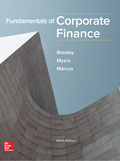
a)
To determine: Stock’s beta after refinancing.
a)
Explanation of Solution
Given information:
Beta of firm entirely by equity and debt is 1, so beta of equity is 0.5 and beta of debt is 0.5.
The formula used is,
Calculation of beta after refinancing:
Hence, value of beta after refinancing is 2.
b)
To determine: Required return and risk premium before refinancing.
b)
Explanation of Solution
Given information:
The return on stock is 10%, and
The risk free
Calculation of risk premium:
Hence, return on stock is 10% and risk premium is 5%.
c)
To determine: Required return and risk premium after refinancing.
c)
Explanation of Solution
Given information:
Debt value ratio is 0.5
Calculation of
Hence, return on equity is 15%
Calculation of risk premium:
Hence, risk premium is 10%.
d)
To determine: Required return on debt.
d)
Explanation of Solution
The required return on debt is here, is as same as risk free rate of 5%
e)
To determine: Required return on asset after refinancing.
e)
Explanation of Solution
Given information:
The return on stock is 15%, and return on debt is 5%
Calculation of return on asset:
Hence, return on asset is 10%
f)
To determine: Percentage increase in EPS after refinancing.
f)
Explanation of Solution
Given information:
Total equity before financing is $10,000
Expected earnings would be $1,000 ($10,000 x 10%)
Calculation of interest:
Calculation of equity earnings:
Calculation of earnings per share before refinancing:
Calculation of earnings per share after refinancing:
Calculation of increase in EPS:
Hence, increase in EPS is 50%.
g)
To determine: New price multiple.
g)
Explanation of Solution
Calculation of new price multiple:
Hence, new price multiple is 6.67
Want to see more full solutions like this?
Chapter 16 Solutions
EBK FUNDAMENTALS OF CORPORATE FINANCE
- Calculate the future value of a lump sum of $1,000 invested for 4 years at 10%, using compounded quarterly.arrow_forwardIf value is not clear then please comment i will write values dont solve question, i will give unhelpful.arrow_forwardwhat are some of the question can i asek my prinsiple of finance teache?arrow_forward
- A critical discussion of the hockey stick model of start-up financing should be presented, supported by recent in-text citations. Provide a detailed explanation of the model. Describe each of the three stages of the hockey stick model of start-up financing, including a detailed characterisation of each stage. The characterisation of each stage should detail the growth, risk, and funding expectations. Present a critical evaluation and an insightful conclu sion.arrow_forwardQuestion Workspace Check My Work New-Project Analysis The president of your company, MorChuck Enterprises, has asked you to evaluate the proposed acquisition of a new chromatograph for the firm's R&D department. The equipment's basic price is $64,000, and it would cost another $18,000 to modify it for special use by your firm. The chromatograph, which falls into the MACRS 3-year class, would be sold after 3 years for $28,400. The MACRS rates for the first three years are 0.3333, 0.4445 and 0.1481. (Ignore the half-year convention for the straight-line method.) Use of the equipment would require an increase in net working capital (spare parts inventory) of $3,000. The machine would have no effect on revenues, but it is expected to save the firm $24,760 per year in before-tax operating costs, mainly labor. The firm's marginal federal-plus-state tax rate is 25%. Cash outflows and negative NPV value, if any, should be indicated by a minus sign. Do not round intermediate…arrow_forwardAlthough the Chen Company's milling machine is old, it is still in relatively good working order and would last for another 10 years. It is inefficient compared to modern standards, though, and so the company is considering replacing it. The new milling machine, at a cost of $108,000 delivered and installed, would also last for 10 years and would produce after-tax cash flows (labor savings and depreciation tax savings) of $19,000 per year. It would have zero salvage value at the end of its life. The project cost of capital is 11%, and its marginal tax rate is 25%. Should Chen buy the new machine? Do not round intermediate calculations. Round your answer to the nearest cent. Negative value, if any, should be indicated by a minus sign.arrow_forward
- If value is not clear then please comment i will write values dont solve question, i will give unhelpful.arrow_forwardFinance subject question solve i need help.arrow_forwardi submitted blurr images mistakely don't amswer.If image is blurr comment please i will write values . dont give answer with incorrect values. i will unhelpful answerarrow_forward
 Essentials Of InvestmentsFinanceISBN:9781260013924Author:Bodie, Zvi, Kane, Alex, MARCUS, Alan J.Publisher:Mcgraw-hill Education,
Essentials Of InvestmentsFinanceISBN:9781260013924Author:Bodie, Zvi, Kane, Alex, MARCUS, Alan J.Publisher:Mcgraw-hill Education,

 Foundations Of FinanceFinanceISBN:9780134897264Author:KEOWN, Arthur J., Martin, John D., PETTY, J. WilliamPublisher:Pearson,
Foundations Of FinanceFinanceISBN:9780134897264Author:KEOWN, Arthur J., Martin, John D., PETTY, J. WilliamPublisher:Pearson, Fundamentals of Financial Management (MindTap Cou...FinanceISBN:9781337395250Author:Eugene F. Brigham, Joel F. HoustonPublisher:Cengage Learning
Fundamentals of Financial Management (MindTap Cou...FinanceISBN:9781337395250Author:Eugene F. Brigham, Joel F. HoustonPublisher:Cengage Learning Corporate Finance (The Mcgraw-hill/Irwin Series i...FinanceISBN:9780077861759Author:Stephen A. Ross Franco Modigliani Professor of Financial Economics Professor, Randolph W Westerfield Robert R. Dockson Deans Chair in Bus. Admin., Jeffrey Jaffe, Bradford D Jordan ProfessorPublisher:McGraw-Hill Education
Corporate Finance (The Mcgraw-hill/Irwin Series i...FinanceISBN:9780077861759Author:Stephen A. Ross Franco Modigliani Professor of Financial Economics Professor, Randolph W Westerfield Robert R. Dockson Deans Chair in Bus. Admin., Jeffrey Jaffe, Bradford D Jordan ProfessorPublisher:McGraw-Hill Education





